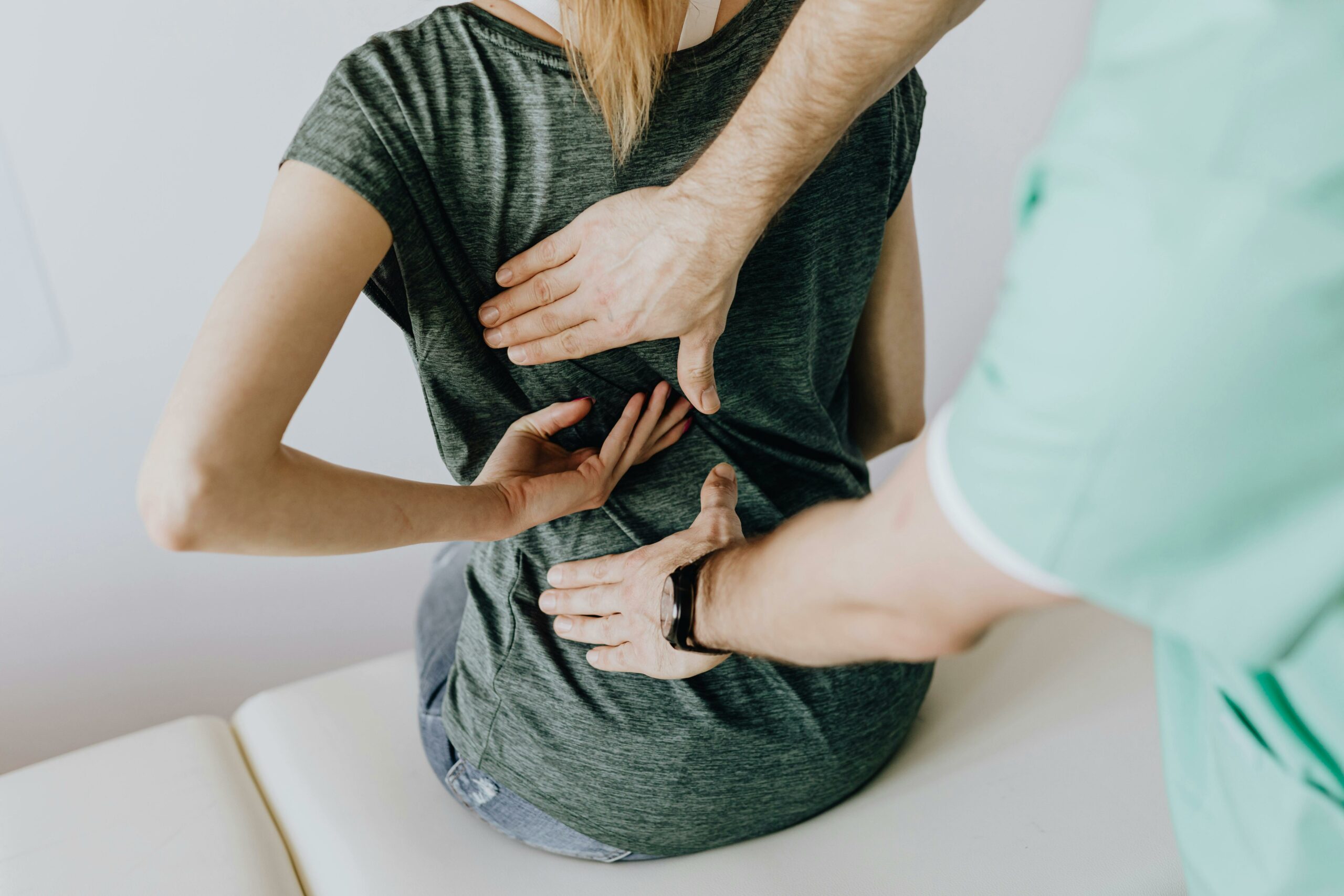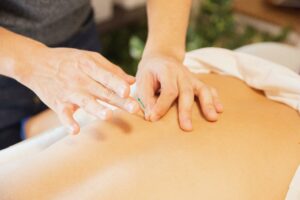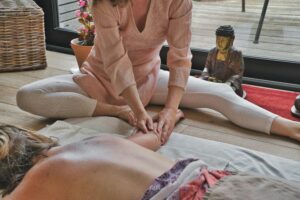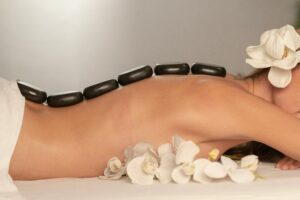Massage Techniques That Helped My Lower Back Pain

Believe it or not, I used to really not like professional massages. I was always picky about who I let touch me, and I certainly had no desire for strangers to do so. All that changed back in 2004, when I hurt my lower back during a training drill in the military. In this article I’ll discuss the wide variety of massage techniques that helped my lower back pain.
It All Began In Basic Training
I was about three-quarters done with basic training and during a specific exercise we were required to buddy up, do a “fireman’s carry” (a way of carrying a person over one shoulder), and carry that buddy down a hill at a jogging pace. The run is roughly seven minutes long and keep in mind that you’re also carrying gear for two.
I am 6’1″ and weighed 220 pounds. I ended up carrying the only bigger guy in my squad who had about an inch and 20 pounds on me. I managed to finish the run, but just as I got to the finish line, I slipped on some gravel and went down hard. I could have sworn I heard some sort of popping noise from my back when this guy landed on it. All I know is that I was in tremendous pain and couldn’t move. I was terrified that I had become paralyzed.
The doctors gave me a full checkup, and assured me that I had just badly wrenched my back, pulled some muscles and all I needed was some rest and gentle physical therapy and all would be back to normal. It certainly seemed that way when I returned to my unit for full duty after three weeks and finished off my basic training and the rest of my army service. My back however, was never the same.
Every year I manage to throw it out once or twice, sometimes seemingly without any reason such as heavy lifting or improper bending. During these periods I suffer mostly from lower back pain that radiates up and tightens my whole back. My doctors and parents kept telling me to go get a professional massage from a credited masseuse and I finally caved. I did a little research because I was tad confused at the variety of options advertised everywhere.
Find The Best Deal On Maple Holistics Massage Oil
I had always assumed that professional massages where an indulgence, something you did to just to unwind (in my defense, many of the advertisements start off with “treat yourself to a pampering massage…”). Yet when I dug a little deeper, I found that some of the earliest written records from thousands of years ago regarding massages referred to their medical uses rather than any relaxation benefits.
The Chinese Huangdi Neijing is a collection of medical knowledge that forms the very basis of traditional Chinese medicine. There, massages are mentioned dozens of times, with the compilation specifying different techniques and how they should be utilized in the treatment of specific ailments and injuries. Other Far-East cultures quickly followed suit, and only much later did medical massages become popular in the West.
Much has been written about the many different kinds of massages, and I obviously won’t write about them all, I will however mention those techniques which have helped me personally the most, all of whom are quite popular, especially for lower back pain.
Just as a short overview, while it can be used purely for relieving stress, massage is a viable non-invasive, low risk method of relieving back pain with little to no side effects. It can be sought by itself or alongside an ongoing medical treatment plan.
Massages essentially work by relieving muscle tension and increasing blood circulation and oxygenation of tissues, improving range of motion and releasing endorphins in the body (“feel good” chemicals that give a sense of euphoria or happiness). Whether your lower back pain is acute or chronic, massage can assist the return to a pain-free, stress-free active lifestyle.
Swedish Massage Explained

Swedish Massage.
In Sweden this technique is called the “classic massage” and for good reason. It is often the best all-around general massage. In the western world it is probably the most widely known form of massage therapy and what many think about when even conjuring up the image of a massage. I can’t help but think of this as the Swiss army knife of massages since it is useful for so many different ailments and for blissful relaxation as well.
This type of massage uses five styles of long, flowing strokes to massage. It combines light stroking in one direction with deep pressure in another to relax and loosen muscles and improve blood flow. There are long, gliding strokes and kneading of the major muscle groups, as well as friction, gentle rhythmic slapping, and vibration. Massage oils are sometimes used to reduce friction, and I’ll mention more about this below in the aromatherapy section. If you’re unsure about trying some of the more exotic styles, this is a good beginner technique that won’t be too rough on your body either.
Acupressure And Shiatsu Massage Explained
For a little help with understanding body energies and such, I spoke to Jamie Bacharach, Licensed Acupuncturist and the Head of Practice at Acupuncture Jerusalem. While plenty of people harbor doubt in regards to the power of qi, there is no denying the relaxing effect of these comparatively gentle massage types. Both of these Asian techniques are similar and I’ve found both to be equally helpful.
Acupressure Massage, Bacharach explained to me, is “a traditional Chinese healing technique that is derived from acupuncture. It employs pressure, with the hand, fingers, elbow, or other devices, on acupuncture points rather than using the traditional needles, to stimulate the body’s natural self-healing abilities.” When acupressure points are pressed, they release muscular tension and help blood circulation and the body’s “energy” to aid in healing.
“In order to remedy the ailments of the body, energy flow needs to be regulated and restored to its proper patterns and levels,” Bacharach explains. “The process of acupressure, which abides by the same principles as acupuncture, is capable of righting the wrongs in energy flow.”

Acupressure.
Shiatsu is a Japanese type of massage therapy that uses pressure specifically applied with the thumbs, fingers and palms. This pressure is applied to the same “meridians” (focal points) as acupressure but incorporates more stretching to balance between the points. It also includes techniques such as rolling, brushing, vibrating, grasping, and in one particular technique, pressure is applied with the feet on the persons back, legs and feet.
Actual acupuncture has never seemed to help me, but I did experience tremendous relief and relaxation with these methods. There is scientific evidence correlating body and mind, so if you are a big believer in Oriental alternative healing, that will most likely help increase the benefits from these two techniques.
Deep Tissue Massage Therapy
This is the most aggressive of the techniques I’ve tried and is certainly not for everyone. One can be left pretty sore after a session, prior to the longer term benefits kicking in. Deep Tissue Massage Therapy is a focused, or targeted, technique designed to relieve severe tension and lack of flexibility in the muscle and the connective tissue, and is often recommended for individuals who experience consistent pain, are involved in heavy physical activity, such as athletes, and patients who have sustained physical injury.
It is important to note that the term “deep tissue” is not the same as “deep pressure.” Deep tissue work is a separate category of massage therapy, employed to treat particular muscular-skeletal disorders and ailments, and uses a certain set of techniques and strokes to achieve relief. A therapeutic “deep pressure” massage can be any that is performed with sustained strong, occasionally intense pressure throughout an entire full-body session, but does not address a specific complaint like deep tissue does.

Deep tissue massage.
Deep Tissue Massage is applied to both the superficial and deep layers of muscles as well as connective tissue. As usually happens in my case, some soreness is to be expected depending on the scope of the work since sessions are often quite intense as a result of the deliberate, focused work.
If you have several points that need to be worked on, an experienced practitioner will not generally use this deep tissue technique for the whole body in one session, but will focus on particular problem areas, and incorporate different, gentler massage techniques on the remainder of the body, switching to another problem point at a different session. This technique might not be as immediately relaxing as much as others, but it is meant for a more serious pain that needs focused attention.
Deep tissue massage targets connective tissue and muscle layers which are found much deeper under the skin than most massage techniques are able to reach. Not everyone will need this, but for chronic pains and aches, particularly chronic lower back pain, deep tissue massage has proven to be one of the most effective massage techniques currently available and has helped me specifically in dealing with sharp shooting pains radiating up my back.
As mentioned above, it is very similar to the therapeutic deep pressure massage, but beyond being deeper and more concentrated on affected areas, the strokes are much slower as well.
Deep tissue massage breaks down and removes in the lower back, which can cause circulation and swelling. When these adhesions have been broken down and removed, circulation is improved, swelling goes down, and improved movement, mobility, and flexibility can be obtained. Though the technique can be rough, I find the end results to be well worth it.
Stone Massage Explained

Stone massage.
Like Acupressure and Shiatsu massages, it helps to believe in body energies and forces. A stone massage uses cold or heated stones to apply pressure and heat. Adding heat to specific areas on the body enhances the feelings of relaxation and peace. The penetrating effect of the heated stones allows the massage to be delivered without excessive pressure.
This is good especially for people who are more sensitive to the rougher techniques, but not too sensitive that that they can’t endure the heat of the stones. This usually isn’t a problem since the massage therapist always holds the stones first before touching them to your body, which ensures that the temperature will not be too hot. Everyone, however, has their own comfort range, so don’t be shy and be sure to speak up if the stones are too hot for you.
The hot stones are usually made of basalt, a type of rock that is rich in iron, so they retain heat. River rocks are normally used because they are smooth – they are smoothed and polished over time by the river current. In some lines of thinking, this smoothing of the stones by the natural forces of nature, increases the energy contained within the stone, and thus increases the healing potential when used in massage.
As the stones are placed along the clients back, especially along acupressure meridians, they help to retain heat which then deeply penetrates into the muscles, releasing tension. Some therapists will use a shaped “body rock”, which is either carved out of stone, or naturally found in that particular shape. This stone is used to amplify the therapist’s own physical strength and focus pressure on certain areas of the body.
The masseuse will also use stones coated in massage oils, or first apply oil to your body, to deliver various smooth massaging strokes. mMost find this technique to be very relaxing and I heartily agree. I often can’t wait to get home and take a nap after a hot stone session.
Thai Massage Explained
The name here is a little misleading as the Thai Massage actually originated in India thousands of years ago. It is based on ancient ayurvedic healing massage principals and Yoga. This technique combines massage and stretches with yoga-like positions.
The northern style of Thai Massage emphasizes stretching while the southern style focuses more on acupressure. If you weren’t flexible before, this northern style might actually help you achieve a broader range of motion. Unlike the other styles mentioned here, traditional Thai massages do not use oils or lotions and the recipient remains clothed.
This is also not a massage that I would recommend for first timers. Thai massage works your entire body. As the therapist rigorously manipulates your body, moving it into yoga-like stretches, the therapist uses every part of his or her body- hands, knees, legs, and feet- to not only stretch you but also apply pressure on your muscles and loosen your joints.
The impact on the body of a Thai Massage is similar to that of yoga for those of you who are familiar with it. The therapist’s assisted stretches guide the body back into proper alignment, improving overall posture. Improved posture then allows the joints to move within their intended ranges and positions, reversing and / or preventing pain.
The stretches in a Thai Massage relieve excess stress on the skeletal structure including the spine and provide lower back relief. The combination of gentle massage and stretches in this technique relaxes and lengthens any tight muscles. This will remove pressure from the back and allows the muscles to fall back into proper alignment, relieving the pain.
I didn’t utilize this massage style so much for the pain relief aspect as much as for the flexibility that it allowed me to return to and maintain.
Aromatherapy Explained
This is not a specific massage technique, rather it is used to enhance other styles and bring out their fullest potential. Certain smells have the ability to trigger various physical and emotional reactions. More than any other style, this one utilizes this fact to the utmost. Dating back to ancient Egypt and Greece, Aromatherapy uses particular essential oils to add to its healing and relaxing technique.
When these oils are used, the massage area is filled with scents to help relax the client, uplift the spirits, and invigorate the body. Each essential oil has its own qualities, and each individual has their own preference as to what scents they enjoy the most. Most professionals are really good about this, and as long as this is not over-used and becomes too overwhelming, I’ve found that the right essential oils will make a good massage into a great massage.
Conclusion
Always consult your doctors and an accredited massage therapist as to what treatments might work best for you. As with any healthy lifestyle, exercise and proper stretching must be a part of your day or week. The human body was built to be in motion, and both are a major component of achieve long term pain relief. In addition to these and massage therapy, other home remedies for lower back pain include good posture and frequently getting off our butts.
Our modern sedentary lifestyle has really taken a toll on our bodies, and all it really takes is a few minutes per day to strengthen core muscles, maintain back health and avoid injury. I’m glad I’ve taken these lessons to heart, and along with working-out more, I have come to not only appreciate a good massage but to utilize it to maintain my quality of life.


